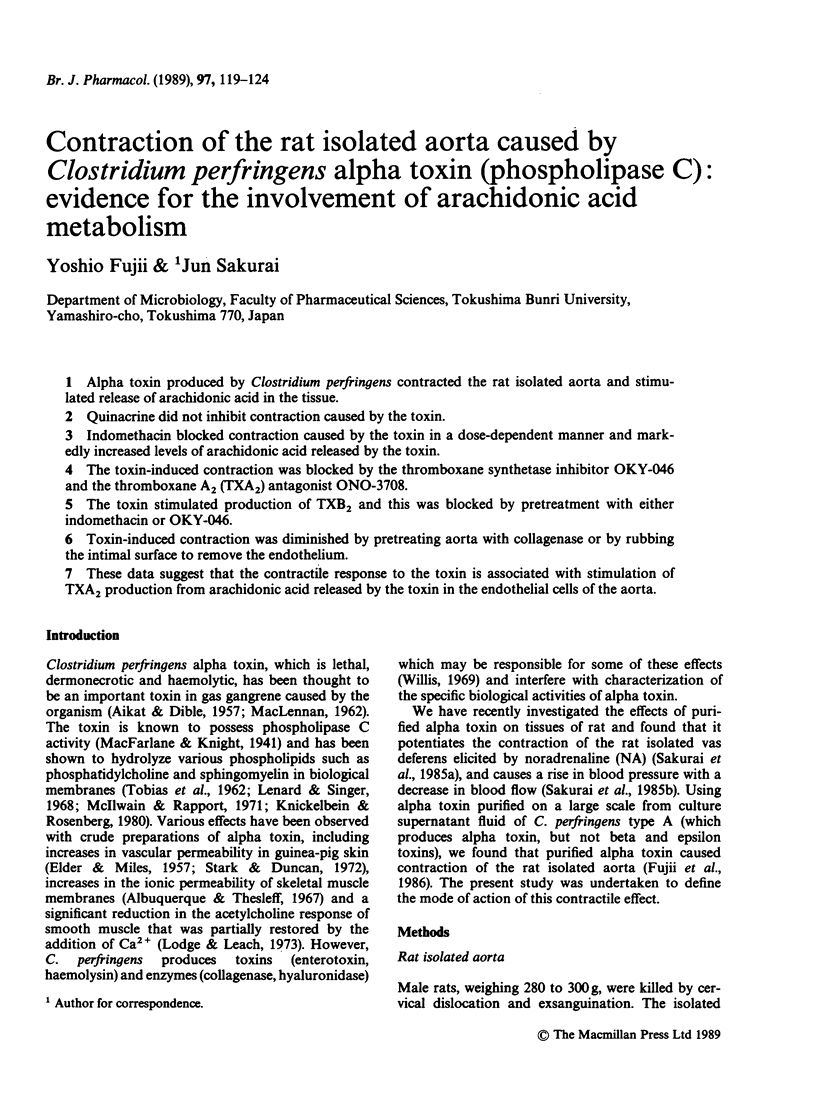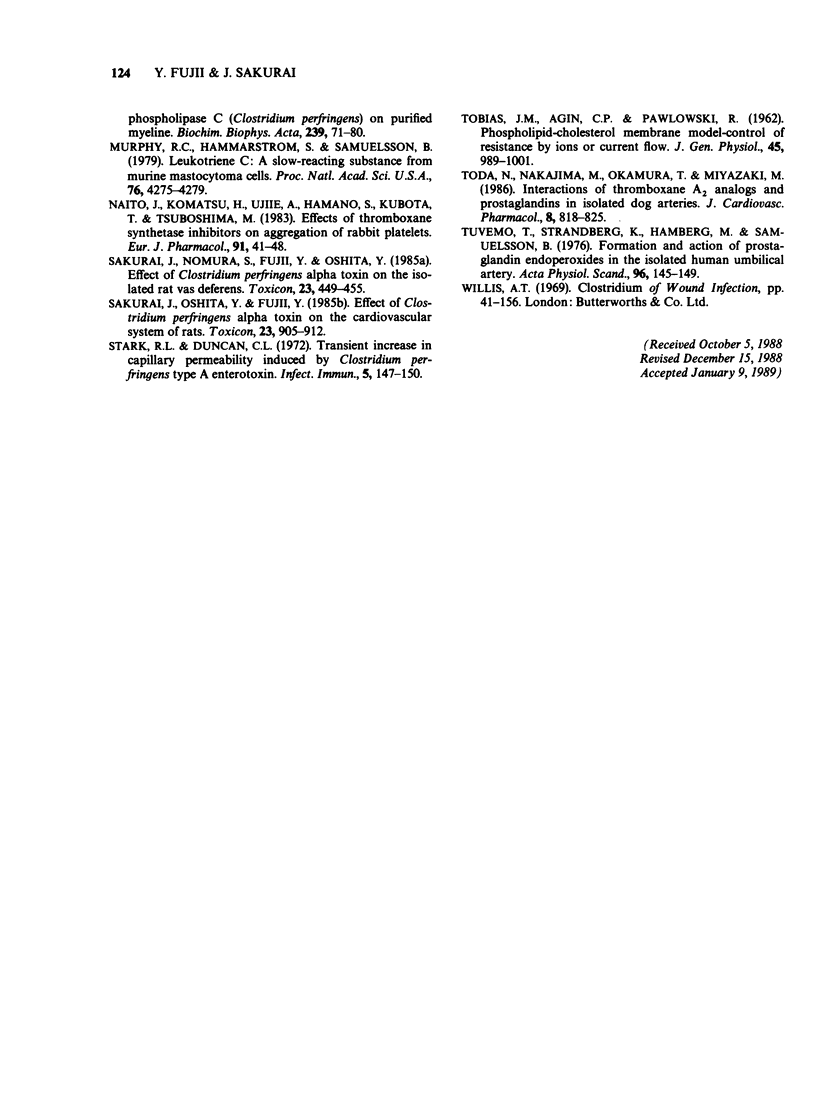Abstract
1. Alpha toxin produced by Clostridium perfringens contracted the rat isolated aorta and stimulated release of arachidonic acid in the tissue. 2. Quinacrine did not inhibit contraction caused by the toxin. 3. Indomethacin blocked contraction caused by the toxin in a dose-dependent manner and markedly increased levels of arachidonic acid released by the toxin. 4. The toxin-induced contraction was blocked by the thromboxane synthetase inhibitor OKY-046 and the thromboxane A2 (TXA2) antagonist ONO-3708. 5. The toxin stimulated production of TXB2 and this was blocked by pretreatment with either indomethacin or OKY-046. 6. Toxin-induced contraction was diminished by pretreating aorta with collagenase or by rubbing the intimal surface to remove the endothelium. 7. These data suggest that the contractile response to the toxin is associated with stimulation of TXA2 production from arachidonic acid released by the toxin in the endothelial cells of the aorta.
Full text
PDF





Selected References
These references are in PubMed. This may not be the complete list of references from this article.
- AIKAT B. K., DIBLE J. H. The pathology of Clostridium welchii infection. J Pathol Bacteriol. 1956 Apr;71(2):461–476. doi: 10.1002/path.1700710220. [DOI] [PubMed] [Google Scholar]
- Albuquerque E. X., Thesleff S. Influence of phospholipase C on some electrical properties of the skeletal muscle membrane. J Physiol. 1967 May;190(1):123–137. doi: 10.1113/jphysiol.1967.sp008197. [DOI] [PMC free article] [PubMed] [Google Scholar]
- Cerletti C., Minoldo S., Bucchi F., Del Maschio A., de Gaetano G. Requirement of ADP for arachidonic acid-induced platelet aggregation: studies with selective thromboxane-synthase inhibitors. Biochem Pharmacol. 1986 Apr 1;35(7):1201–1203. doi: 10.1016/0006-2952(86)90161-9. [DOI] [PubMed] [Google Scholar]
- Chau L. Y., Tai H. H. Release of arachidonate from diglyceride in human platelets requires the sequential action of a diglyceride lipase and a monoglyceride lipase. Biochem Biophys Res Commun. 1981 Jun;100(4):1688–1695. doi: 10.1016/0006-291x(81)90713-0. [DOI] [PubMed] [Google Scholar]
- Frye R. A., Holz R. W. Phospholipase A2 inhibitors block catecholamine secretion and calcium uptake in cultured bovine adrenal medullary cells. Mol Pharmacol. 1983 May;23(3):547–550. [PubMed] [Google Scholar]
- Fujii Y., Nomura S., Oshita Y., Sakurai J. Excitatory effect of Clostridium perfringens alpha toxin on the rat isolated aorta. Br J Pharmacol. 1986 Jul;88(3):531–539. doi: 10.1111/j.1476-5381.1986.tb10233.x. [DOI] [PMC free article] [PubMed] [Google Scholar]
- Fujioka M., Nagao T., Kuriyama H. Actions of the novel thromboxane A2 antagonists, ONO-1270 and ONO-3708, on smooth muscle cells of the guinea-pig basilar artery. Naunyn Schmiedebergs Arch Pharmacol. 1986 Dec;334(4):468–474. doi: 10.1007/BF00569388. [DOI] [PubMed] [Google Scholar]
- Furchgott R. F., Zawadzki J. V. The obligatory role of endothelial cells in the relaxation of arterial smooth muscle by acetylcholine. Nature. 1980 Nov 27;288(5789):373–376. doi: 10.1038/288373a0. [DOI] [PubMed] [Google Scholar]
- Hamberg M., Samuelsson B. Detection and isolation of an endoperoxide intermediate in prostaglandin biosynthesis. Proc Natl Acad Sci U S A. 1973 Mar;70(3):899–903. doi: 10.1073/pnas.70.3.899. [DOI] [PMC free article] [PubMed] [Google Scholar]
- Ingerman-Wojenski C., Silver M. J., Smith J. B., Macarak E. Bovine endothelial cells in culture produce thromboxane as well as prostacyclin. J Clin Invest. 1981 May;67(5):1292–1296. doi: 10.1172/JCI110157. [DOI] [PMC free article] [PubMed] [Google Scholar]
- Ingerman-Wojenski C., Silver M. J., Smith J. B., Nissenbaum M., Sedar A. W. Prostacyclin production in rabbit arteries in situ: inhibition by arachidonic acid-induced endothelial cell damage or by low-dose aspirin. Prostaglandins. 1981 Apr;21(4):655–666. doi: 10.1016/0090-6980(81)90014-9. [DOI] [PubMed] [Google Scholar]
- Knickelbein R. G., Rosenberg P. Differential phospholipid hydrolysis by phospholipase C in sarcolemma of muscles with calcium or sodium generated action potentials. Toxicon. 1980;18(1):71–86. doi: 10.1016/0041-0101(80)90033-1. [DOI] [PubMed] [Google Scholar]
- Krug E. L., Kent C. Phospholipase C from Clostridium perfringens: preparation and characterization of homogeneous enzyme. Arch Biochem Biophys. 1984 Jun;231(2):400–410. doi: 10.1016/0003-9861(84)90403-x. [DOI] [PubMed] [Google Scholar]
- Lenard J., Singer S. J. Structure of membranes: reaction of red blood cell membranes with phospholipase C. Science. 1968 Feb 16;159(3816):738–739. doi: 10.1126/science.159.3816.738-a. [DOI] [PubMed] [Google Scholar]
- MACLENNAN J. D. The histotoxic clostridial infections of man. Bacteriol Rev. 1962 Jun;26:177–276. [PMC free article] [PubMed] [Google Scholar]
- Macfarlane M. G., Knight B. C. The biochemistry of bacterial toxins: The lecithinase activity of Cl. welchii toxins. Biochem J. 1941 Sep;35(8-9):884–902. doi: 10.1042/bj0350884. [DOI] [PMC free article] [PubMed] [Google Scholar]
- McIlwain D. L., Rapport M. M. The effects of phospholipase C (Clostridium perfringens) on purified myelin. Biochim Biophys Acta. 1971 Jun 8;239(1):71–80. doi: 10.1016/0005-2760(71)90194-9. [DOI] [PubMed] [Google Scholar]
- Murphy R. C., Hammarström S., Samuelsson B. Leukotriene C: a slow-reacting substance from murine mastocytoma cells. Proc Natl Acad Sci U S A. 1979 Sep;76(9):4275–4279. doi: 10.1073/pnas.76.9.4275. [DOI] [PMC free article] [PubMed] [Google Scholar]
- Naito J., Komatsu H., Ujiie A., Hamano S., Kubota T., Tsuboshima M. Effects of thromboxane synthetase inhibitors on aggregation of rabbit platelets. Eur J Pharmacol. 1983 Jul 15;91(1):41–48. doi: 10.1016/0014-2999(83)90359-x. [DOI] [PubMed] [Google Scholar]
- Sakurai J., Nomura S., Fujii Y., Oshita Y. Effect of Clostridium perfringens alpha toxin on the isolated rat vas deferens. Toxicon. 1985;23(3):449–455. doi: 10.1016/0041-0101(85)90028-5. [DOI] [PubMed] [Google Scholar]
- Sakurai J., Oshita Y., Fujii Y. Effect of Clostridium perfringens alpha toxin on the cardiovascular system of rats. Toxicon. 1985;23(6):903–912. [PubMed] [Google Scholar]
- Stark R. L., Duncan C. L. Transient increase in capillary permeability induced by Clostridium perfringens type A enterotoxin. Infect Immun. 1972 Jan;5(1):147–150. doi: 10.1128/iai.5.1.147-150.1972. [DOI] [PMC free article] [PubMed] [Google Scholar]
- TOBIAS J. M., AGIN D. P., PAWLOWSKI R. Phospholipidcholesterol membrane model. Control of resistance by ions or current flow. J Gen Physiol. 1962 May;45:989–1001. doi: 10.1085/jgp.45.5.989. [DOI] [PMC free article] [PubMed] [Google Scholar]
- Toda N., Nakajima M., Okamura T., Miyazaki M. Interactions of thromboxane A2 analogs and prostaglandins in isolated dog arteries. J Cardiovasc Pharmacol. 1986 Jul-Aug;8(4):818–825. doi: 10.1097/00005344-198709010-00025. [DOI] [PubMed] [Google Scholar]
- Tuvemo T., Strandberg K., Hamberg M., Samuelsson B. Formation and action of prostaglandin endoperoxides in the isolated human umbilical artery. Acta Physiol Scand. 1976 Feb;96(2):145–149. doi: 10.1111/j.1748-1716.1976.tb10183.x. [DOI] [PubMed] [Google Scholar]


